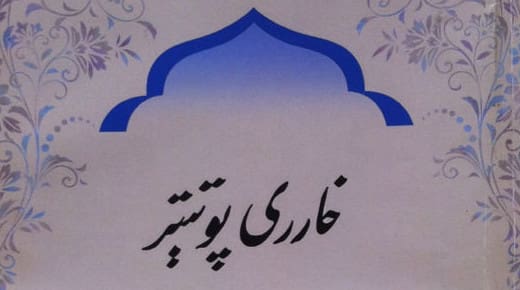 Harry Potter and the Uighur Enigma
Harry Potter and the Uighur Enigma
ThePotterCollector came to me with an intriguing photo of a book the seller claimed to be a Uighur translation of the Philosopher’s Stone (obviously unauthorized).
Unfortunately, these are the best images available and most of the text is not very legible. Is it enough to say with any confidence that this is what the seller claims it to be?
The first things to note:
- No Harry Potter related cover art. That’s unusual even for an unauthorized translation.
- The script is Arabic but atypical Arabic. There are a lot more extra “dots” floating around than you typically see, and it’s more disjointed than usual.
- The “title”, if you assume that the large text in the centre is the title, seems pretty short.
- The last image has a page of simplified Chinese text.
1 and 3 lean slightly to the “con” side of the argument, but aren’t conclusive in any way. 2 is to be expected: Uighur is a Turkic language that is written with the Arabic script so it shouldn’t look like regular Arabic just like you would expect Turkish to not look like English or French or Vietnamese or any other language written with the Latin script. 4 seems a little odd, but not terribly surprising given that most Uighur speakers are in the “Xinjiang Uyghur Autonomous Region” of China. So 2 and 4 slightly leaning “pro”, but again not very conclusive.
The Arabic text in the smaller images is totally illegible, at least for a non-speaker, so we have to focus on the cover. One is naturally drawn to the title:
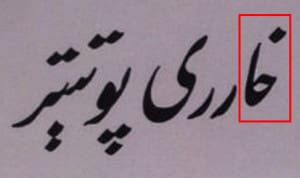
But that first character! Anyone with a cursory understanding of the Arabic script (in Arabic) would be like “what the heck is that ‘b’-lookin’ thing?” They would also realize that this is clearly pretty stylized text; possibly even hand-written. So… maybe let’s look for lower-hanging fruit.
The text at the top is interpretable, even if some of the fine detail is missing:

And there are a couple of things that immediately stand out. First, the character that is circled in the second row on the left is the least ambiguous. It is pretty clearly:
ۆ
This is a character romanized as “oe” or “ö” that is only used in Uighur, Kurdish, Kazakh and Azerbaijani. Azerbaijani has not been written with the Arabic script since 1922, so we can ignore it as a possibility.
Next, there’s a similar character on the top row, the second circled one. It’s a little harder to tell what’s going on above it, but it looks most likely to be a cluster of three dots making it this character:
ۋ
This is a character romanized as “v” only used in Uighur and Kazakh, so we can rule out Kurdish as a possibility.
Lastly there is the first circled character on the top; that’s pretty unusual. Not many characters in Arabic have tails that go to the right. A quick look at a the Uighur alphabet though and you can tell it is:
ئا
a complex ligature of the letters ا, “alef”, and ئ, “Yeh + hamza” romanized as “a”. This is a character unique to Uighur and Kurdish, so we can rule out Kazakh as well. That leaves just Uighur as the most likely candidate for the language.
Back to the title and the ‘b’ thing…

with a little more context from looking at the text above, it’s not a big leap to see that the ‘b’ is actually the same ئا that is the first circled character we just examined. With a big fat calligraphy pen, “hamza”, the little diacritic, is a pretty difficult shape to make. For a native speaker, replacing it with a ‘dot’ is not going to be very confusing and closing the the bowl can be written off as a stylistic liberty.
The last two characters (reading right to left) with dots above and below are pretty obviously two complex ligatures and it takes a second to realize that they are on a bit of a slope. I.e. if they were typeset, you would expect the ligatures to stick to the baseline a little better, but they start high on the right and swoop down to the left as though written on an angle. Again, stylistic liberty; but once you realize that, they look a little more normal. In Arabic, extra points usually indicate a letter and what that letter is often indicated by the dots. So counting those, will give you a starting point of how many letters you’re looking at.
Based on that, in the first (again right to left) complex ligature, you can guess there are two letters (two groups of dots) and in the second three (two groups of dots plus the longer tail at the end that extends beyond the dots).
The dots below provide the best starting point; three dots below is not very common in Arabic and in this context that has to be a پ, “peh”. Two *vertical* dots stacked underneath is even rarer, and actually gives us further evidence that this is Uighur. It can only be a ې, “e” or “ë” which is only used in Pashto and Uighur. Side note: this is rare because in the Arabic script, most vowels are not explicitly indicated; an artefact of the structure of Semitic languages which makes ignoring vowels less confusing. That doesn’t work so well for Uighur and so, unlike Arabic, all vowels are specified when writing Uighur.
Most of the remaining characters are standard Arabic script; the last leap that one has to make to understand the title is with regards to the character ligatured to پ, “peh”; it looks like
ۊ
but that is not a character used in Uighur. However, given the stylistic liberties already taken, it’s not unreasonable to interpret that character as
ۆ
especially once we put it in the context of what we already have worked out. I believe that the text in title is:
ئاررى پۆتېر
Which transliterated to Latin is:
arri pötër
This is a plausible transliteration of “Harry Potter”. There is no /h/ sound in Uighur so it is not unusual for it to be dropped. The double “r” is actually kind of weird; it’s really just an artefact of English spelling which is not usually carried through into transliterations. You would expect that if they went to the trouble of doubling the “r”, they would also double the “t” in “Potter”, but it doesn’t appear to be. There are plausible explanations for this though: perhaps the double-r disambiguates Arri from another Uighur word. It’s also possible that my interpretation of the title is not correct; an examination of the actual book would conclusively decide it.
One way or another, though, I’m comfortable saying that it is a book about Harry Potter.
Is it the Philosopher’s Stone though? The text at the bottom of the cover would probably tell us but it’s also stylized, fuzzy and not easily interpretable. Plus, whereas transliterating “Harry Potter” is illuminating because it is borrowed from English, transliterating the text there is likely less informative unless one actually spoke Uighur.
A quick search seems to indicate that “stone” in Uighur is tash which is a cognate of the Turkish taşı or taş from the Turkish titles. In Arabic script that would be:
تاش
although undoubtedly inflected. From a cursory inspection, it doesn’t really look like there are good candidates for a match in the text at the bottom. Time to move on from the cover. The Chinese text is the next best place to look.

It’s pretty fuzzy, but also pretty clearly:
哈利・波特与魔法石
which is, of course, the Simplified Chinese title of Harry Potter and the Philosopher’s Stone. Although this is still not conclusive evidence and I would love to inspect the actual book for more evidence that it is what it appears to be, I’d say it’s a pretty good chance that this is an unauthorized Uighur translation of Harry Potter and the Philosopher’s Stone.
Based on my analysis ThePotterCollector decided to get the book and he kindly promised me the opportunity to check it out! So there’s a good chance there will be an update in the not-so-distant future.
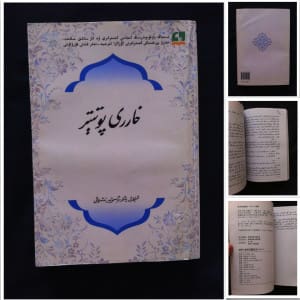
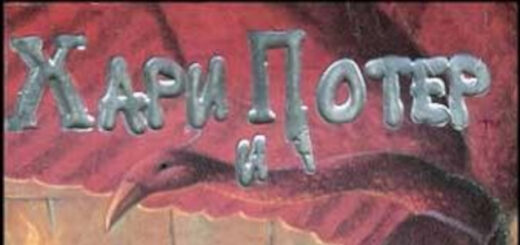
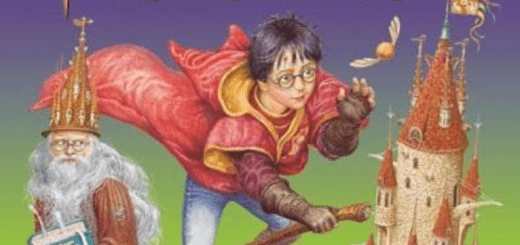
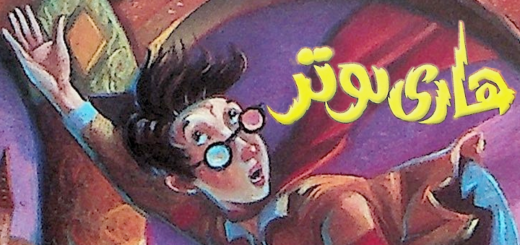

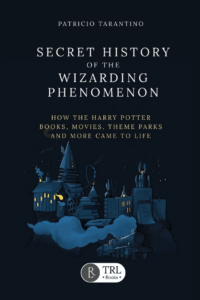


This is so crazy and exciting! I can wait to see what else we find out about this.
I know right! 🙂 I love this kind of stuff!
That “first letter” that “looks like a b” is actually two letters. خا
Yup, you are totally right! There were a couple of problems with my original analysis that have since been corrected. Obvious once you say it. 😉 I’ve been intending to write an update, but since I wrote the first one, I’ve had a baby and bought a new house! Kind of a lot of change! It’s coming though.
The finally confirmed title is on “The List” if not updated here yet. 🙂 Thanks for reading and for taking the time to provide the feedback!
Ok, I accidently stumbled upon this blog and saw this discussion. I’m a Uighur so I think I should give some explanation. First, No Harry Potter related cover is true enough but this is definitely Uighur translation of Harry Potter though on the book cover there is no mention of “the Philosopher’s Stone”. Besides I don’t think this is an unauthorized translation because the words on the bottom of the cover tell us that it is an authorized publisher.
And it’s true that the script is Arabic, as you know we use Arabic script in writing.
The title is actually just two words, translations of “Harry Potter”. As you said, “Philosopher’s Stone” is not part of the title.
But the Chinese text contains something like “Magic Stone” or similar words.
Honestly I haven’t read this book before. I didn’t even know that there was a Uighur translation of Harry Potter. But the cover and other texts indicate that this is none other than Harry Potter. Even I as a native speaker is having difficulties to read the other texts.
If you want to know more about Uighur related books or other subjects, you can just ask.
Here are some different font styles of Uighur language in case you want to check it out, some of them look a lot like pictures.
http://www.ukij.org/fonts/
Tahir, thank you so much for your reply! I really appreciate it! Sorry for the response delay; I had a baby and then moved so life has been a little hectic!
I am definitely intending a follow up to this original post because I have since actually acquired the book and have been able to examine it much more closely. And others have responded to the post with more information as well, but I’m delighted to have a native speaker!
There were three primary factors that lead to me believing that it was an unauthorized translation:
* It doesn’t appear on JK Rowling’s contact list (which admittedly appears to be poorly updated)
* There’s no cover art; it would be the first authorized translation that didn’t have at least the default cover art
* It wasn’t available online, but other Uighur books from the same publisher were available at, for example, amazon.cn
But I am very intrigued by the fact that it says so on the cover. Any further thoughts on that or the above?
Since Uighur isn’t available on Google Translate or anything like that it has been quite difficult searching for information about the book; if you come across any online articles, posts etc—even ones in Uighur—I would love it if you let me know!
Hello again, this time I should be the one who is sorry for the response delay! In the first few weeks I did check this blog for updates and later on with the endless responsibilities of life I simply forgot about this discussion. Just last night I had the sense to check again and there it was!
When it comes to the three factors you mentioned above, I don’t know much about JK Rowling’s contact list, honestly.
But having no cover art is actually a mistake I believe, especially for a book like “Harry Potter” there should be intriguing cover art at least for the sake of children.
Apart from this particular translation, I noticed during online search that there are number of other books with the exact same cover from this same publisher. And from what I know so far this translation was published in 2002, why it hasn’t been sold in the bookstores in the region widely is a mystery to me, I mean children love Harry Potter, don’t they?
Even I couldn’t find this exact translation anywhere online. But the good news is there is another Uighur translation of “Harry Potter Philosopher’s Stone” which was republished in 2012, apparently the second edition of the book you currently have. And this time there is cover art as well with the full title of the book.
Here is the URL: http://www.kitabhana.com/goods.php?id=10670
The URL takes you to an online bookstore which is in Uighur unfortunately.
Lastly, it would be so great if Uighur were available on Google Translate. We’ve been trying to add Uighur to Google Translate for a while now. Hopefully it’ll be there soon.
Since English is not my native tongue I make mistakes sometimes, unintentionally of course. If such mistakes were made in my post, I sincerely apologize.
That’s fantastic! Thank you so much for posting that link!
The cover art is interesting because that particular art is from a video game and it was used on one other book that I know of: the unauthorised Nepali translation!
The book that I have is published in 2012 as well, actually, in April; looks like this one was a reprint that was done in August.
There’s definitely something fishy going on though. They both claim:
本书根据人民文学出版社2002年2月第12版第1次印刷本翻译出版
Which appears to be saying that they are the first printing of the 12th edition of a translation produced by the People’s Literature Publishing House in 2002. The kitabhana one says that the print run was 1-13630; however, mine says it was 1-8160. This appears to be a convention in China? My Simplified Chinese copy has this, but the print run numbers are *something very high* – *something very high*.
Also if this was actually a 12th edition, you would expect to see many many more copies of the book floating around, no? But you can’t find it hardly anywhere — not even on either of the publisher’s sites. I don’t think this one is any more authorised than mine…
I think you misunderstood this line of Chinese:
本书根据人民文学出版社2002年2月第12版,第1次印刷本翻译出版
The book you have and the one on the Kitabhana online store are not the 12th edition at all, but rather translated into Uighur based on that 12th edition of Chinese translation which was published 2002 by People’s Literature Publishing House.
And the one they’re selling on Kitabhana is actually the first print of the second edition. So I believe the one you have is the first print of the first edition and they’re both published by Xinjiang Youth Publishing House as I said earlier translated based on that 12th edition of Chinese translation which was published 2002 by People’s Literature Publishing House.
There may be tons of copies of the Chinese version in China I have no doubt. And I think that print run 1-13630 and 1-8160 are normal considering readers who read in Uighur.
Other than that, on that website it’s said this edition is also distributed to the public by Xinhua Bookstore. I don’t think the idea that selling authorized books in Xinhua Bookstore does not make much sense. Besides that Kitabhana bookstroe claims that they don’t sell authorized books. But again, this is China who knows? right?
Well, I think I should check the regional Xinhua Bookstore in case they still have the book.
One more thing, if you want to buy books from Kitabhana, they can ship your orders to your address internationally.
>The book you have and the one on the Kitabhana online store are not the
>12th edition at all, but rather translated into Uighur based on that 12th
>edition of Chinese translation which was published 2002 by People’s
>Literature Publishing House.
Actually, that is what I thought initially! But Google’s translation made me second-guess myself! (I don’t read Chinese, but I do read Japanese and I worked with Chinese quite a bit so there’s enough overlap that I can often make out the gist.) So thank you for confirming that.
> is also distributed to the public by Xinhua Bookstore
I saw that as well on the copyright page (新疆新华书店) and bookstore seems to have a site: http://www.xjxhsd.com.cn/ with an online store, but I wasn’t able to find anything there.
> I don’t think the idea that selling authorized books in Xinhua Bookstore does not make much sense. Besides that Kitabhana bookstroe claims that they don’t sell authorized books.
No, and I do actually agree with you there… but the question is “authorized” by who? When I say “authorized” I mean specifically by J.K. Rowling. I *suspect* that when Kitabhana says it, they mean it is the genuine publication of Xinjiang Juvenile Publishing (XJP) printed by Xinjiang Xinhua Printing. As opposed to someone, in China, who was making unauthorized copies of Xinjiang Juvenile Publishing’s book.
But whether or not XJP had permission from J.K. Rowling to create a Uighur translation, I think, is a completely different question. Or even whether XJP had permission from People’s Literature Publishing House (PLPH). If PLPH *had* produced the Uighur translation, I would be open to the idea that they, being the official PRC publisher could have negotiated rights for Uighur as part of their Chinese rights, but that does not seem to be the case.
I really think the most compelling factor is still the cover art—every authorized translation which did not commission it’s own unique cover art, uses the standard Philosopher’s Stone cover and if this one was authorized by J.K. Rowling, or even by PLPH, I’m sure that they would have used it too.
I also think that it’s explicitly not being sold online by big companies which otherwise carry many XJP books because it is an unauthorized translation of a very high profile book.
>I don’t think the idea that selling authorized books in Xinhua Bookstore does not make much sense. Besides that Kitabhana bookstroe claims that they don’t sell authorized books.
Oh my god! I made a grievous mistake here. I meant “unauthorized” here not “authorized”. What the hell was I thinking when I was typing? I’m really sorry.
>Oh my god! I made a grievous mistake here. I meant “unauthorized” here not “authorized”. What the hell was I thinking when I was typing? I’m really sorry.
LOL! Don’t worry about it! It’s pretty clear from context that’s what you meant. 😉 Nice thing about language—lots of redundancy that helps keep the intention even in a noisy signal. 🙂